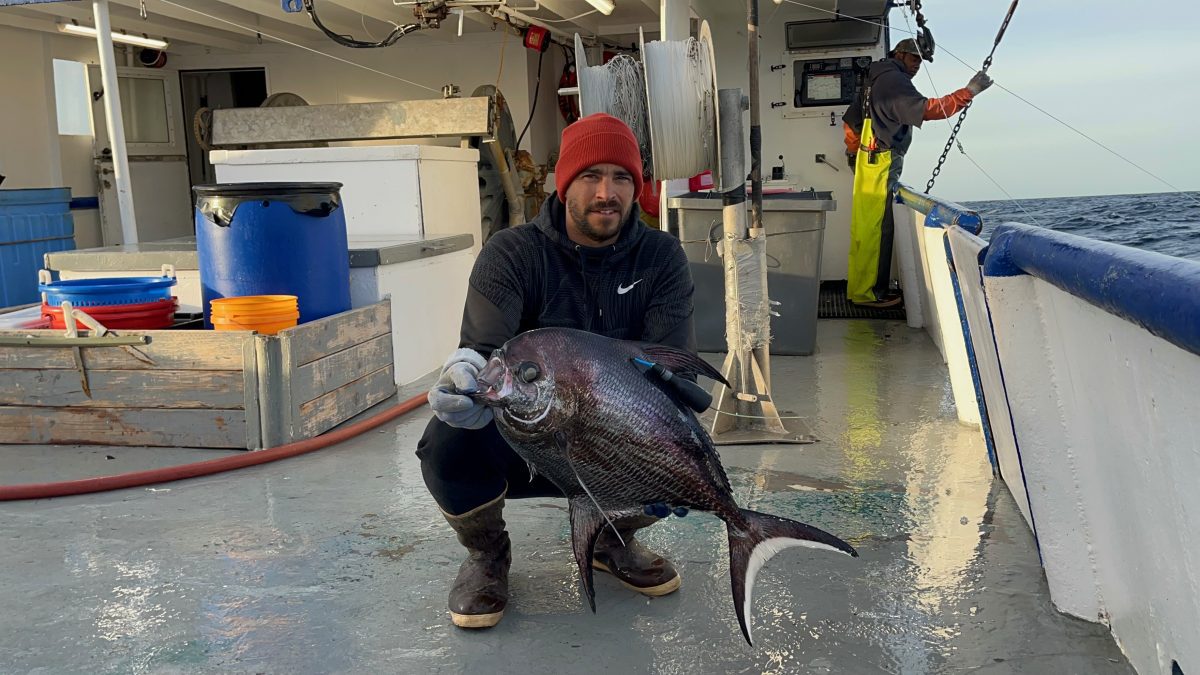Bigscale pomfret are an ocean enigma
 Scientists followed the movements of big-scale pomfret by fitting them with satellite-based tracking tags and releasing them back to the ocean. (Photo courtesy: Danny Mears)
Scientists followed the movements of big-scale pomfret by fitting them with satellite-based tracking tags and releasing them back to the ocean. (Photo courtesy: Danny Mears) September 18, 2025
WHOI scientists delve into the elusive fish’s role in the food web
Woods Hole, Mass. – Woods Hole Oceanographic Institution (WHOI) researchers have shown large sharks can spend hours deep in the oceans' mesopelagic zone, which lies 200 to 1,000 meters (650 to 3,300 feet) below the surface. This region is home to more biomass than any other layer of the ocean, but most of its inhabitants are too tiny to serve as meals for large predators, so why are they spending so much time there?
A new study published in Marine Ecology Progress Series highlights the important roles of mid-sized predators, such as bigscale pomfret, linking the upper and lower layers of the ocean foodweb. Until now, scientists didn’t have enough data on how this fish—and similar species—move, making it hard to understand their behavior and role in the ecosystem. In this study, researchers used satellite-based tracking tags to follow the pomfret’s movements, something that was previously hard to do with deep-sea fishes.
“The data shows bigscale pomfret are permanent residents of the ocean’s twilight zone, and follow the pattern of diel migration. This means they stay deep during the day and come to shallower waters to feed at night,” said Martin Arostegui, lead author of the study and a research associate at WHOI. “Since these species spend a majority of their life on the move and in hard-to-reach places, it wouldn’t have been possible for us to tag enough of them during a few days at sea. Thus, we collaborated with a commercial longline fisher, Captain Danny Mears, who did that work as part of our research team.”
"Bigscale pomfret are so different from the tunas and swordfish we usually catch that we are fascinated by them whenever they show up in our gear," Mears said. "My crew and I were excited for the opportunity to help with the satellite tagging for this study. It's been very rewarding to see the data."
This new research also provides insight into how water clarity affects bigscale pomfrets' migration patterns. When the fish moved from the Slope Sea to the clearer waters of the Sargasso Sea, their behavior changed noticeably. This indicates that water clarity influences the depth these fish occupy, which could impact food webs by changing the prey they target and their susceptibility to predators such as large sharks.
“We always talk about the mesopelagic layer like it’s this giant buffet for big predators—but we’ve been skipping over the species in the middle,’ said WHOI biologist Camrin Braun, the senior author of the study and principal investigator of WHOI’s Marine Predators Group. “These mesopelagic fish are doing the hard work of connecting the deep ocean to the surface food web. If we don’t understand them, we’re basically trying to solve a puzzle with the middle pieces missing.”
###
About Woods Hole Oceanographic Institution
Woods Hole Oceanographic Institution (WHOI) is a private, non-profit organization on Cape Cod, Massachusetts, dedicated to marine research, engineering, and higher education. Established in 1930, its mission is to understand the ocean and its interactions with the Earth as a whole, and to communicate an understanding of the ocean’s role in the changing global environment. WHOI’s pioneering discoveries stem from an ideal combination of science and engineering—one that has made it one of the most trusted and technically advanced leaders in fundamental and applied ocean research and exploration anywhere. WHOI is known for its multidisciplinary approach, superior ship operations, and unparalleled deep-sea robotics capabilities. We play a leading role in ocean observation and operate the most extensive suite of ocean data-gathering platforms in the world. Top scientists, engineers, and students collaborate on more than 800 concurrent projects worldwide—both above and below the waves—pushing the boundaries of knowledge to inform people and policies for a healthier planet. Learn more at whoi.edu.
